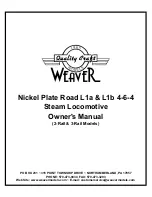
11
FLYING
NOTE: If you get these fuel lines mixed up, look down into the
engine compartment and observe the fuel tank. The fuel line going
to the lowest part of the tank is the “fuel” line; it goes to the carb. The
other line that goes to the upper part of the tank is the “vent” line; it
goes to the muffler. Realize that the fuel system is a “closed loop” sys-
tem; the back pressure in the muffler maintains a positive fuel flow
to the engine. Any air leaks in the system will degrade performance.
E. Start the engine
Carefully read and understand the Engine Operating Instructions
furnished so you are familiar with the operation of a model airplane
engine. As it comes in your Super Combo or Regular Combo Plus, it
should be ready to start as installed. Simply “choke” the engine, hook
up a hot 1.2V-1.5V battery to the glow plug, and flip the prop with a
“chicken stick” or an electric starter. Follow the break-in procedures
in the Engine Operating Instructions for the first 4 or 5 flights.
VI. FLYING
It is strongly recommended that you have a qualified instructor
teach you to fly. Without training, the likelihood of having a mishap is
increased greatly, just as if you were flying a real airplane. Also, there
are several good computer simulators on the market that can help
teach you the skills necessary for success. Talk to your hobby dealer
about instructors available in your area plus the simulators that he has
available.
You should join the Academy of Model Aeronautics. This mem-
bership is required by most clubs plus it provides liability insurance in
the case of an accident. Contact the AMA at:
5151 East Memorial Dr., Muncie, IN 47302
GETTING ORIENTED
We recommend that you find a large smooth and clear surface to
practice taxing your airplane around in before you try a take off.
To taxi, you only need to use the rudder stick. At the slow speeds
encountered during taxing, the elevator and ailerons will not be
effective. The first and most important thing to remember when con-
trolling model aircraft is: the model controls are set up to operate as if
you were sitting in the cockpit of the model. This means that when
you pull back (down) on the elevator stick the nose of the plane will
go up. Moving the rudder stick to the right will “yaw” the plane to the
right and moving the aileron stick to the right will “roll” the plane to
the right. Pretty simple right? Well, not quite. Since you are really stand-
ing on the ground and not sitting in the plane, this is how the controls
work when you are facing the same direction the plane is flying.The
problem is that when the plane is flying towards you, the rudder and
aileron controls seem reversed to the inexperienced pilot. This is the
reason we recommend that you practice taxing around in a large open
area to try and get used to the control reversal.
During your first few flights, try to face the direction that the plane is
flying and looking over your shoulder as needed.This makes it a little
easier to pretend that your sitting in the cockpit.
FIRST FLIGHT
When you are comfortable with the controls, you should be ready
for your first flight. Go over the Pre-Flight Check List one more time
for good measure and taxi out to the runway (hopefully with an expe-
rienced pilot by your side). Point the model directly into the wind and
gradually increase the throttle to full throttle. As the model starts
rolling forward it may try to turn to the left due to the engine torque.
Apply enough right rudder to keep the plane rolling relatively straight
into the wind. If you built the model with right thrust, this tendency
may not be noticeable. As the plane picks up speed, the right rudder
input can be reduced.
Once the plane reaches flying speed, it will probably try to fly by
itself. If the grass seems to be impeding takeoff, a very slight amount of
“up” elevator can be applied, but it is very important that you do not
apply too much up elevator too early or the plane will stall and roll
over into the ground.
As the plane becomes airborne, reduce the “up” elevator and
allow the plane to pick up flying speed while gently gaining altitude.
Once a safe flying speed and altitude has been obtained, feel free to
turn the airplane back toward the flying field. Make all control inputs
smoothly and gradually so you can see the effect they have on the
plane.A small amount of “up” elevator will need to be applied to keep
the plane level during turns.You should be able to reduce the throttle
to about 1/2 throttle for normal cruising flight which will reduce the
flying speed and give you more time to think about what is going on.
You will find that once airborne, you can fly the plane with only the
aileron and elevator sticks.This is perfectly fine and will make it much
easier for you to learn.
If the plane has a tendency to turn, roll, climb, or dive, you can
adjust the transmitter trims to correct this. On your first flights, it
might be a good idea to have an experienced pilot make the adjust-
ments for you while you fly the plane.
If you get disoriented or the plane gets out of control, simply take
your hands off all the controls and allow the plane to stabilize. Clear
your head and try to picture yourself sitting in the cockpit.Then input
Содержание Tiger Trainer MK II
Страница 2: ...2 Notes...






























